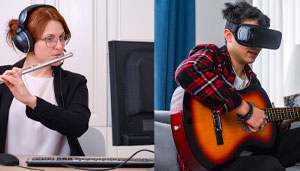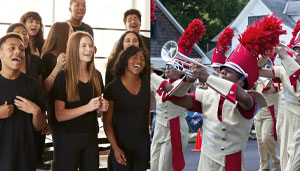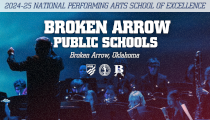Top Ten Strategies to Support Girls in the Middle School Jazz Band
By Jenny L. Neff & Gregg Eskin on October 25, 2022 middle school PrintThe following list was the focus of a session shared with educators at the inaugural Key of She Jazz Conference. While the list contains strategies to support ALL students, it was through the Key of She Jazz Conference that we were able to look through the lens of young women in our jazz bands.
The list was inspired by the problems and solutions cited by the Women in Jazz Organization (WIJO), founded by Roxy Coss in 2017, to address many of the issues women and non-binary people face in the world of jazz.
The Key of She Jazz Conference was the brainchild Olivia Hughart, who initiated the start of an all-girls jazz band (Key of She) when she was in middle school. The group expanded as she moved through high school, and by the time Olivia was a senior, she planned the Key of She Jazz Conference as a senior project and event in April of 2019. The authors of this article co-presented a session at the conference on the following Top 10 Strategies to Support Girls in the Group:
- Empower Our Students
Celebrate students’ successes along the way. Middle school can be a difficult transition time. Celebrate strengths. Encourage growth. For girls in the jazz ensemble, help build their confidence by encouraging them to try new things. Nobody wants to be the “quota filler” or “token girl” that balances the numbers, but rather acknowledged for skill and talent.
- Support Personal Development
Throughout the middle years, students take some big steps and become more self-sufficient and self-confident. As adults, we can model positive behaviors, reward appropriate risk-taking, and acknowledge students who are doing the right thing. Create opportunities and teachable moments for students to learn from their mistakes.
- Create a Safe Learning Space
Creating a safe learning space can be our physical space as well as the community we build in our ensembles. For groups with a smaller number of girls, it’s even more important to build and promote this sense of community. We need to be aware of times when students may feel singled out or when the spotlight is on them for the wrong reasons, as well as being in tune with how students are treating each other.
- Build Community
We build community as part of our safe learning space, but it can extend beyond the rehearsal room walls. We can connect with similar ensembles across the district or with other programs. We can also bring in professionals from the field to inspire our students. For girls in the group, connecting with other girls or women with whom they can identify is so important at this developmental stage. These role models can have a positive impact for a lifetime.
- Foster Mentorship
Connecting students to other students for support is an amazing partnership we can create in the music world. Olivia Hughart, student founder of Key of She, was able to connect the girls from Key of She with other girls in the district as well as girls she met at outside festivals and auditions. As teachers, we can help foster these connections. It makes our students more confident and our ensembles safer spaces where creativity to blossom.
- Dismantle Barriers
Are we aware of bullying and stereotypes that might occur or be happening in our classrooms? Do you address inappropriate sidebar comments that are made before or after rehearsal, or do you let them slide? Are there instrument gender themes that need to be changed? Do you assign parts and student roles in a gender-neutral way? Do you show diversity in your teaching examples (recordings, videos, posters, etc.)? What are we modeling?
- Teach Appropriate Advocacy
When students come to you with their voice, do you listen? Can you guide students in the right direction? At this level, they may still need our help in moving forward.
- Create Opportunities - Pathways
Do you promote a growth mindset in your classroom? It’s crucial during this time of adolescent change and transition that we continue to support students even when they might not know what or how to do something. Promote the power of YET! They might not know something, but they are well on their way to success. Similarly, choosing pathways over problems when possible is motivating.
- Help Students Find Their Voice
Middle school students are what we call “survivors.” They are trying to figure out who they are and where they fit in. We need to make sure students have access to learning opportunities; and it might not be in a traditional way. By helping them gather tools and develop skills to navigate beyond the school walls, they can find and use their voice.
10. Reflect on Our Programs
Traditions without reflection can become tragic. Traditions transformed can be powerful motivators and part of the fabric of a positive and inclusive culture of our programs. How has your program evolved? What do you wish for?
Schools are a reflection of the community, and our communities are a reflection or our schools. Preparing our students to succeed outside of the school walls is an important part of our charge as educators. How well are you addressing the needs of your students?
Authors
Jenny Neff, EdD, is program Director and Professor of Music Education at the University of the Arts. She is a frequent guest conductor, clinician, adjudicator, presenter, and writer on a variety of topics in music education. Her complete bio can be found at http://www.JennysCreativeEDge.com
Gregg Eskin recently retired as Middle School Instrumental Director for grades 6, 7, and 8 Band, Orchestra, and Jazz Band. He plans to continue his career as a clinician, adjudicator, and educator along with public performances.
Jenny L. Neff & Gregg Eskin
This article first appeared in in the National Association for Education’s Teaching Music magazine, © April 2020. NAfME advocates at the local, state, and national levels; provides resources for teachers, parents, and administrators; hosts professional development events; and offers a variety of opportunities for students and teachers. The Association has supported music educators at all teaching levels for more than a century. Check out NAfME here: (https://nafme.org/).
Most Recent Articles







